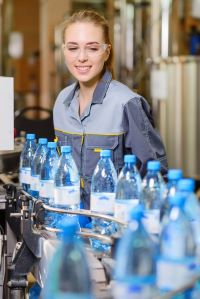- All product testing must be done by methods approved by the government agency or agencies having jurisdiction
- Records must be maintained of the date of sampling, type of product sampled, production code, and test results
- Records, including source and supply water approvals, must be maintained at the plant for at least two years
Source Water
- Samples of source water from each source in use by the plant must be taken and analyzed as often as necessary, at a minimum of once/year for chemical contaminants and once every four years for radiological contaminants
- Source water from other than a public system must be sampled and analyzed for total coliform at least once/week (follow-up testing is required for any positives to identify if E. coli is present)
- Firms that use a public water system for source water may substitute public water testing results showing compliance with all provisions of the United States Environmental Protection Agency (EPA) National Primary and Secondary Drinking Water Regulations for chemical contaminant
- Firms that do not use a public water source may reduce the frequency of their testing of that source, as well as the number of chemicals they test for, if the firm can document that such reduction is consistent with a state-issued waiver under the EPA regulations
Product Water
- Samples of product water must be taken after processing and prior to bottling, and analyzed as often as necessary to assure uniformity and effectiveness of processing performed by the plant via an approved method
- A bacteriological swab and/or rinse count should be made from at least four containers and closures just prior to filling and sealing, and conducted at least once every three months
Finished Product Water
- Bacteriological analysis for total coliform on a representative sample must be taken from a batch or segment of a continuous production run for each type of bottled water produced during one day's production run at least once/week. For chemical, physical, and radiological testing, a representative sample must be taken from a batch or segment of a continuous production run for each type of bottled drinking water produced during a day's production at least once/year.

Testing Requirements
- All product testing must be done by methods approved by the government agency or agencies having jurisdiction
- Records must be maintained of the date of sampling, type of product sampled, production code, and test results
- Records, including source and supply water approvals, must be maintained at the plant for at least two years
Source Water
- Samples of source water from each source in use by the plant must be taken and analyzed as often as necessary, at a minimum of once/year for chemical contaminants and once every four years for radiological contaminants
- Source water from other than a public system must be sampled and analyzed for total coliform at least once/week (follow-up testing is required for any positives to identify if E. coli is present)
- Firms that use a public water system for source water may substitute public water testing results showing compliance with all provisions of the United States Environmental Protection Agency (EPA) National Primary and Secondary Drinking Water Regulations for chemical contaminant
- Firms that do not use a public water source may reduce the frequency of their testing of that source, as well as the number of chemicals they test for, if the firm can document that such reduction is consistent with a state-issued waiver under the EPA regulations
Product Water
- Samples of product water must be taken after processing and prior to bottling, and analyzed as often as necessary to assure uniformity and effectiveness of processing performed by the plant via an approved method
- A bacteriological swab and/or rinse count should be made from at least four containers and closures just prior to filling and sealing, and conducted at least once every three months
Finished Product Water
- Bacteriological analysis for total coliform on a representative sample must be taken from a batch or segment of a continuous production run for each type of bottled water produced during one day's production run at least once/week. For chemical, physical, and radiological testing, a representative sample must be taken from a batch or segment of a continuous production run for each type of bottled drinking water produced during a day's production at least once/year.


